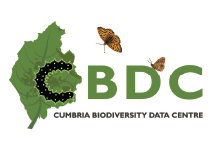CBEB Species Statements
Species statements for selected key species that occur in Cumbria. The below PDFs provide information on:
- Legal and Conservation Status
- Habitat
- Ecology
- Distribution
- Conservation Issues
- Planning Considerations
- Enhancement Opportunities
- Further information and Contacts
- Current Action in Cumbria

BARN OWL Tyto alba
Barn Owls, their nests and eggs are protected by UK legislation. The greatest threats to Barn Owl populations in Cumbria are loss of suitable nests sites through barn conversions etc., and lack or loss of feeding habitat through agricultural intensification.
BATS (ALL SPECIES) Chiroptera
Bats and their roosting sites are protected by European and UK legislation. The greatest threat to bats comes from loss of roosts due to demolition, alteration and repair of buildings or structures, felling of trees, and through direct disturbance of breeding and hibernation roosts.- .

GREAT CRESTED NEWT Triturus cristatus
Great Crested Newts and their breeding and foraging habitats are protected by UK and European legislation. The greatest threat to Great Crested Newt in Cumbria is destruction of their ponds and surrounding terrestrial habitat.
HEN HARRIER Circus cynaeus
Hen Harriers, their nests and eggs are protected by UK and European legislation. In Cumbria the greatest planning-related threat to Hen Harriers arises from developments which threaten specific breeding and winter roost locations. .
.NATTERJACK TOAD Epidalea calamita
Natterjack Toads and their breeding sites are protected by UK and European legislation. Inappropriate or lack of management is currently the greatest threat to the Natterjack Toad at its existing sites in Cumbria
OTTER Lutra lutra
The Otter, its holts and resting places are protected by UK and European legislation. The greatest threats to Otters come from habitat loss, often associated with watercourse development, road mortality and water pollution, and disturbance.
RED SQUIRREL Sciurus vulgaris
Red Squirrels and their dreys are protected by UK legislation. The greatest threat to Red Squirrels is the spread of the non-native Grey Squirrel which competes for food and carries disease.
REPTILES (ALL NATIVE SPECIES) Reptilia
Four reptile species are found in Cumbria: Common Lizard Lacerta vivipara, Slow-worm Anguis fragilis (a legless lizard), Grass Snake Natrix natrix and Adder Vipera berus. All are protected by UK legislation. The greatest threats to reptiles in Cumbria are from habitat loss and fragmentation due to unsympathetic management and development.
SMALL BLUE BUTTERFLY Cupido minimus
The Small Blue butterfly is particularly vulnerable to the loss of habitat through development of brownfield sites or through scrub encroachment leading to the loss of kidney vetch, its food plant.
WATER VOLE Arvicola terrestris
Water Voles and anywhere they use for shelter or resting are protected by UK legislation. The greatest threat to Water Vole populations is through loss of suitable habitat through agricultural intensification and predation by the non-native mink.
WINTERING GEESES & SWANS
Pink-footed Geese, Barnacle Geese and Whooper Swans winter or pass through Cumbria mainly between September and early May. They are protected by UK and European legislation. The greatest threat to these species comes from development that affects their feeding grounds, especially wind farms.










